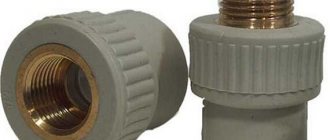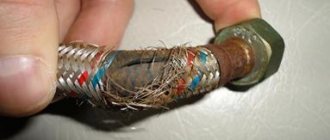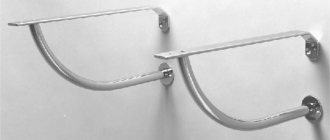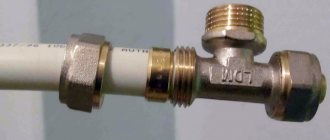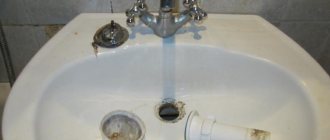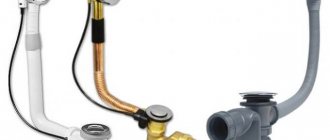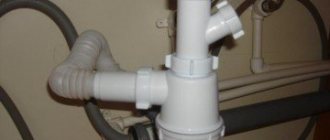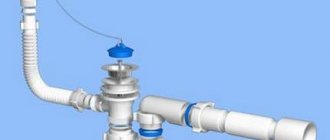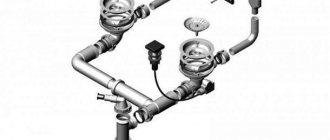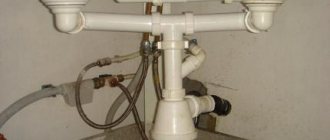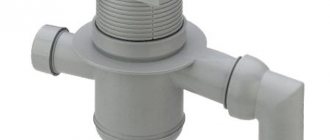How to connect a siphon to the sewer: selection and step-by-step installation instructions
09.11.2018
A siphon is a curved type of drain fitting that connects plumbing to the sewer system.
The product is necessary to form a water seal that prevents the passage of unpleasant odors from the waste system into the room.
Small debris is also retained in the bend, which reduces the likelihood of clogging.
Before you figure out how to connect a siphon to a sewer pipe, it is important to choose the right drain fittings.
Types of siphons
- Bottle (flask) - has a slightly expanded lower part. It is in this knee that small debris and fat are retained, which can be removed by partially disassembling the structure. The task can be simplified by washing with special cleaning agents. Ideal for kitchen sinks.
- Pipe - has a U- or S-shape. The design is non-removable, so there is a hole at the bottom of the product for servicing the drain. Suitable for connecting shower cabins, urinals, toilets.
- Corrugated pipe - it is easy to give such a siphon the desired shape, adjusting it to the location of the sewer outlet. The minimum number of connections and low weight significantly reduce the risk of leaks. At the same time, fat and small debris quickly accumulate in the folds of the corrugated material.
- The branched design is the best choice for a modern kitchen with a double sink and/or washing machine and dishwasher. Several outlets allow you to collect wastewater into one pipe.
- Combined system - is a universal bottle model with a corrugated hose.
- Products with overflow are a necessary solution for a bathtub that has a hole to prevent overflow.
- A drain is a special siphon for a bath or shower.
Assembly
Almost anyone can assemble a siphon for a kitchen sink on their own. Installation and assembly of a sanitary fixture is not as difficult as it might seem at first, but performing such work requires a responsible approach. Improper installation of the device may cause unpleasant odors or water leakage at the connections of the pipes.
When purchasing a product, you need to pay special attention to its packaging. Rubber gaskets must be smooth and solid. The device is disassembled in the presence of a store employee to ensure that all components are available. It is better to return siphons with chips, cracks and burrs. During operation, such products will leak.
When choosing a siphon for the kitchen, you need to pay attention to the following points:
- the diameter of the metal grid for filtering wastewater and the drain hole of the sink must match;
- possibility of connecting household appliances to the siphon. If it is necessary to connect such equipment, the user must buy a device that has the ability to connect additional hoses;
- There should be enough free space under the sink to install a siphon. If this is not the case, you need to buy a smaller device;
- diameter of the sewer system socket. If the pipe has a smaller cross-section than required, to seal the junction of the parts, select a rubber adapter, which should fit tightly into the hole;
- attractive appearance of the device, regardless of its location (in an open area or disguised under a kitchen cabinet). Products made of chrome-plated steel look beautiful, although their cost is much higher than plastic ones.
If used properly, chrome-plated metal parts can last as long as plastic parts. Therefore, when choosing a sanitary fixture, you must be guided not by its functionality, but by its appearance.
What to consider when choosing
- Features of connected plumbing equipment.
- Location of sewer pipe.
- Availability and volume of free space for installation of drain fittings, dimensions of the siphon and outlet.
- Choose a high-quality siphon for a cast iron pipe or plastic outlet that complies with GOST 23289–94.
- Characteristics of materials. Thus, plastic is lightweight, not subject to corrosion or rotting, but less durable than metal. Cast iron is reliable and durable, but has more weight. Copper alloys are universal, but expensive and become covered with a thin layer of oxides over time.
Installation of a siphon using the example of a plastic structure
- Fix the sink and connect the sewer pipe to it.
- Install a drain funnel with a rubber seal into the sink and tighten the nut for secure fixation.
- Connect the lower part of the siphon to the drain pipe.
- Place the drain tube in such a position that it does not reach the bottom of the flask 2-3 cm.
- Place union nuts and wedge-shaped “crackers” on the connecting pipes (each of them is inserted into the gap between the tube and the siphon and tightened with nuts).
Keep in mind that metal models are installed according to an identical scheme, but in them “crackers” replace flange connections.
Eliminate minor inaccuracies
Any defects during the installation of the siphon must be corrected immediately. If leaks are detected, it is necessary to check the reliability of the gaskets and the presence of cracks on them. It is also recommended to probe the pipe for delamination or damage. Leaks often occur when the nuts are too tightly or loosely tightened.
The smell of sewage in an apartment occurs for several reasons.
- No water lock. Often occurs when using corrugated pipes and not bending them sufficiently. Also, the water from the water seal could simply evaporate if no one lived in the apartment for a long time.
- Siphon malfunction. If you hear a squelching sound during drainage, this indicates a sharp jump in the drained water. The only solution is replacement.
- Small diameter of the sewer riser, faulty ventilation of the sewage system. The solution to such a problem must be entrusted to specialists.
Removing blockages
It must be said that even preventive measures are not always able to prevent blockages from occurring. Therefore, below we will look at how to clean a pipe in a sink.
Removing debris from the siphon
As mentioned above, most often a plug forms in the siphon. Therefore, in some cases, the easiest way to remove the blockage is simply by disassembling and clearing the drain of debris. Depending on the type of structure, this is done as follows:
| Glass siphon | At the bottom of the glass there is a lid that you need to unscrew and simply pull out the debris with your hands. In some cases, it may also be necessary to disconnect the drain pipe from the siphon. |
| In the form of corrugation | In this case, you need to pull the corrugation out of the sewer pipe, free it from the clips and straighten it. To remove debris, you can push it with a wooden rod or cable. This must be done carefully so as not to damage the corrugation, which is susceptible to mechanical stress. |
If a non-separable tubular siphon is installed under the sink, which is difficult to dismantle, or the blockage does not occur in the siphon, but in the sewer pipes, then it can be eliminated in two ways:
- Mechanical;
- Chemical.
Below we will take a closer look at each method.
In the photo - cleaning a sink with a plunger
Mechanical method
The simplest mechanical way to remove blockages is to clear them with a plunger. This simple device is present in almost every apartment.
The plunger is used as follows:
- First of all, you need to fill the bowl with a small amount of water so that it covers the drain hole.
- Then you need to plug the overflow hole.
- Next, you should close the drain hole with the rubber bulb of the plunger and make several active pumping motions.
- If after this the water does not go away, the procedure must be repeated.
- After removing the blockage, pour a pan of boiling water or hot water into the drain.
Note! To avoid frequent clogging of the sewer, the diameter of the sewer pipe for the sink should be at least 40-50 mm.
It is not uncommon for a blockage to be so serious that it is impossible to remove it with a plunger. In this case, a plumbing cable will help solve the problem.
Work with this device is performed in the following sequence:
- The end of the cable is inserted into the sewer through the drain hole and at the same time slowly rotated. During operation, the cable should not sag so that it does not twist. Therefore, it is more convenient to do cleaning together.
- When the stop (plug) is reached, several reciprocating movements are performed, which will ensure its destruction.
- Then the cable must be removed and washed with water.
Note! If the plumbing fixture is connected using a corrugated siphon, then before cleaning the pipe in the sink, the corrugation must be disconnected from the sewer so as not to damage it.
Chemical method
If you don’t have a plumbing cable at hand, you can try to remove the blockage in the sink using a chemical method. There are special chemicals for these purposes, and their price is usually quite affordable. The only thing is, before purchasing such a product, you need to make sure that it is suitable for your type of pipe.
Among these drugs, the most popular are:
- Mister Muscle;
- Tiret;
- Mole, etc.
Pipe cleaner
The products can be sold both in liquid form and in the form of dry powder, however, the principle of their action is the same.
As a rule, cleaning pipes using these drugs looks like this:
- First of all, you need to scoop the water out of the bowl.
- Then a drain cleaner is poured or poured into the drain hole.
- After this, the sink should be left in this form for one and a half to two hours. Depending on the type of product, the time may vary.
- After the specified time, you need to fill the sink with a small amount of water and make several active pumps of the plungers. In most cases, after these manipulations, the water forms a funnel and quickly goes down the drain.
Note! When using a chemical, you must wear gloves and avoid getting it on your skin or clothing. If it was not possible to avoid getting a drop on the skin, the area should be rinsed with copious amounts of water.
In most cases, all these methods allow you to remove the blockage yourself. If the plug is deeper in the sewer pipes and you cannot remove it yourself, you will have to seek the help of specialists.
Here, in fact, is all the information on servicing the sink drain and eliminating blockages in it.
Installation of a combined drainage system under the sink: operation diagram
Even an inexperienced home craftsman can install a siphon; just follow the step-by-step instructions for connecting sewer pipes to outlet fittings.
- We put a large flat gasket on the top of the flask-shaped unit and secure it with a lid. The product is ready for installation.
- We take a corrugated pipe, onto which at one end you need to put a union nut and a cone-shaped gasket. We insert this side into the siphon from the side and secure the structure with a nut.
- We repeat the operation with the pipe that goes into the upper part of the drain assembly.
- We put a gasket on the opposite end of the pipe and twist it with the drain, on which a nut is pre-installed.
- With one hand we hold the pipe, and with the other we install a metal drain with a rubber seal in the sink hole (this can be done in advance). Install and tighten the screw.
- We attach the corrugated siphon pipe to the drain system using an O-ring lubricated with sealant.
- We check the structure for leaks.
Device and purpose
A product such as a siphon serves to remove used liquid and small impurities into the sewer system. Due to the presence of a bend, the design for the sink leaves a small amount of water in the pipe, which forms a filter. It prevents sewer noise and unpleasant odors from penetrating back into the room.
Each type of plumbing fixture has a common design and a universal operating principle. The device is a pipe or pipe system, which includes pipes and a reservoir. On one side, the devices are connected to the drain opening in the sink, on the other, they are connected to the sewer system. The used water flows into the siphon, then passes through the pipe and enters the general sewer riser. The system is protected from clogging by a mesh filter located at the sink opening.
If the siphon is equipped with an overflow function, then the package includes an additional pipe, which can be easily attached to the overflow hole in the sink. Some models have special side fittings for connecting hoses of household appliances - washing machines and dishwashers. Products for sinks with two bowls are equipped with a duplicate outlet.
The design must be resistant to chemical and thermal influences. Therefore, plastic and metal are used for its manufacture.
A product made of PVC is the cheapest option, but its service life, even with everyday use, is 7 years.
As for propylene products, their price is 15-20% higher than their PVC counterparts. With high-quality installation, such a siphon for a kitchen sink will last for decades. Unlike chrome-plated structures, chemically resistant, durable propylene is cleaned with a metal cable or hook.
Important. Plumbing structures made of plastic, brass or bronze are the best choice. The latter have a galvanic coating, so they do not oxidize, are resistant to corrosion and are durable, while stainless steel devices are rare and, compared to other types of siphons, are unreasonably expensive. From the point of view of practicality, durability and ease of use, plastic siphons for kitchen sinks with overflow are not inferior to the same metal ones.
Equipment
The standard equipment set includes the following elements:
- metal grate for drainage - the optimal cell diameter is no more than 10 mm;
- inlet/outlet pipe;
- connecting screw with a diameter of up to 8 mm;
- frame;
- union nuts;
- sewer outlets;
- O-rings for sealing joints.
Installing a siphon for a kitchen sink involves the possibility of installing a corrugated or rigid drain pipe. Give preference to the latter option, since small waste and dirt intensively accumulate on the internal hollows of the corrugation. In addition, a rigid pipe is much more difficult to accidentally damage with objects that are under the sink.
Reference. Due to the elasticity and mobility of the corrugated pipe, such an outlet can be easily placed anywhere. At the same time, it has a number of disadvantages: due to its soft structure, the pipe sags, thereby causing blockages, and wears out much faster than the rigid element. Also, the ribbed inner surface of the pipe also tends to accumulate contaminants, causing the material to stretch and lose its shape.
When purchasing a siphon, pay attention to the color, quality of the gaskets and the material of the fasteners. Black rubber gaskets are used in cheaper models of siphons. Another disadvantage of such seals is their visibility, which violates the aesthetic appearance of the structure. Among fasteners, the most durable are stainless steel bolts and nuts, as they are resistant to moisture.
An important additional element that allows you to install a siphon for a kitchen sink is a semi-liquid or plastic sealant. However, before purchasing it, you should check the product for acidity. If the chemical does not have a pungent vinegar odor, then the sealant is suitable for such work.
Connecting the toilet to the sewer
The toilet outlet can be positioned vertically, horizontally or at an angle of 45 degrees. In the first case, a direct connection to the sewer using a rubber cuff is sufficient. With a horizontal outlet, the simplest and most economical solution would be to install plastic pipes. The connection to the sewer can be strengthened with cement mortar.
If the drain is located at an angle, the siphon is connected using a corrugated pipe. With the help of an internal membrane, it is fixed on the pipe of a plumbing fixture, and with the help of an external membrane, it is fixed in the opening of the drainage system. It is recommended to use a reinforced version of a corrugated pipe or an eccentric type cuff.
Assembly nuances
Before installing a siphon under a kitchen sink, you need to read the instructions for assembling it. If there is no such document in the box, then you can connect the siphon yourself, following our instructions:
- There is no need to use a screwdriver to assemble the device. It is better to use a regular or Phillips screwdriver for this purpose. This will help maintain the threads and prevent cracks in the plastic pipe.
- Before fixing the outlet pipe, rubber gaskets are installed. They are attached to the sink body on both sides. To prevent leaks at the joints, a special sealant is used.
- The distance between the sink body and the glass is adjusted using a plastic nut with a spacer. The reservoir is installed in the desired position, then the lock is tightened.
- The nuts must be tightened with optimal force so as not to strip the threads.
At the final stage of work, all joints between parts are carefully inspected and any remaining sealant is removed.
